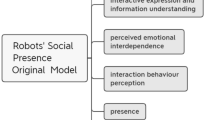Abstract
The use of video mediated communication technologies for interacting is increasing. An extension of these is mobile robotic telepresence (MRP) systems, video conferencing systems mounted on teleoperated mobile robots. The nature of the interaction via an MRP system is more complex than face-to-face interaction and involves not only social communication but also mobility. This research focuses on the use of MRP systems in domestic settings in elder care and contributes to the understanding of how interaction is affected by MRP system embodiment.

Similar content being viewed by others
Explore related subjects
Discover the latest articles, news and stories from top researchers in related subjects.Notes
See “Hello Pat” at: http://vimeo.com/42391813.
Presence is about the sense of being in other environments and with others.
Kendon’s F-formation system is a well-known theory. The spatial relationship during interaction reflects how we may be involved with one another [4].
References
Biocca F, Harms C (2002) Networked minds social presence inventory (scales only version 1.2). http://cogprints.org/6742/. Accessed 03 Oct 2013
Coradeschi S, Loutfi A, Kristoffersson A, von Rump S, Cesta A, Cortellessa G, Gonzalez J (2011) Towards a methodology for longitudinal evaluation of social robotic telepresence for elderly. In: Proceedings of the HRI 2011 workshop social robotic telepresence, pp 1–7
Giraff (2013) http://www.giraff.org. Accessed 03 Oct 2013
Kendon A (1990) Conducting interaction: patterns of behavior in focused encounters. Cambridge University Press, Cambridge
Kristoffersson A (2013) Measuring the quality of interaction in mobile robotic telepresence systems using presence, spatial formations and sociometry. Ph.D. thesis, Örebro university, Sweden. Available online: http://www.diva-portal.org/smash/get/diva2:622369/SUMMARY01.pdf
Kristoffersson A, Coradeschi S, Loutfi A (2013) A review of mobile robotic telepresence. Adv Hum Comput Interact 1–17
Kristoffersson A, Coradeschi S, Loutfi A, Eklundh KS (2013) Assessment of interaction quality in mobile robotic telepresence: an elderly perspective. Interact Stud (In press)
Kristoffersson A, Coradeschi S, Loutfi A, Severinson-Eklund K (2011) An exploratory study of health professionals’ attitudes about telepresence technology. J Technol Hum Serv 29(4):263–283
Kristoffersson A, Coradeschi S, Severinson Eklundh K, Loutfi A (2013) Towards measuring quality of interaction in mobile robotic telepresence using sociometric badges. Paladyn. J Behav Robot 4(1):34–48
Kristoffersson A, Eklundh KS, Loutfi A (2013) Measuring the quality of interaction in mobile robotic telepresence a pilot’s perspective. Int J Soc Robot 5:89–101. doi:10.1007/s12369-012-0166-7
Lawton MP (1985) The elderly in context. Perspectives from environmental psychology and gerontology. Environ Behav 17:501–519
Lombard M, Ditton T (2004) A literature-based presence measurement instrument the temple presence inventory (TPI) (BETA). In: PRESENCE 2004: the 7th annual international workshop on presence
Moreno JL (1953) Who shall survive? Foundations of sociometry, group psychotherapy and sociodrama, rev. edn. Beacon Press, New York
Woods SN, Walters ML, Koay KL, Dautenhahn K (2006) Methodological Issues in HRI: a comparison of live and video-based methods in robot to human approach direction trials. In: Proceedings of the 15th IEEE international symposium on robot & human interactive communication (Ro-Man’06), pp 51–58
Acknowledgements
The work in this thesis was performed within the context of the Ambient Assisted Living Joint Programme project ExCITE-AAL-2009-2-125, Enabling SoCial Interaction Through Embodiment [2].
Author information
Authors and Affiliations
Corresponding author
Rights and permissions
About this article
Cite this article
Kristoffersson, A. Using Presence, Spatial Formations and Sociometry to Measure Interaction Quality in Mobile Robotic Telepresence Systems. Künstl Intell 28, 49–52 (2014). https://doi.org/10.1007/s13218-013-0281-0
Published:
Issue Date:
DOI: https://doi.org/10.1007/s13218-013-0281-0




